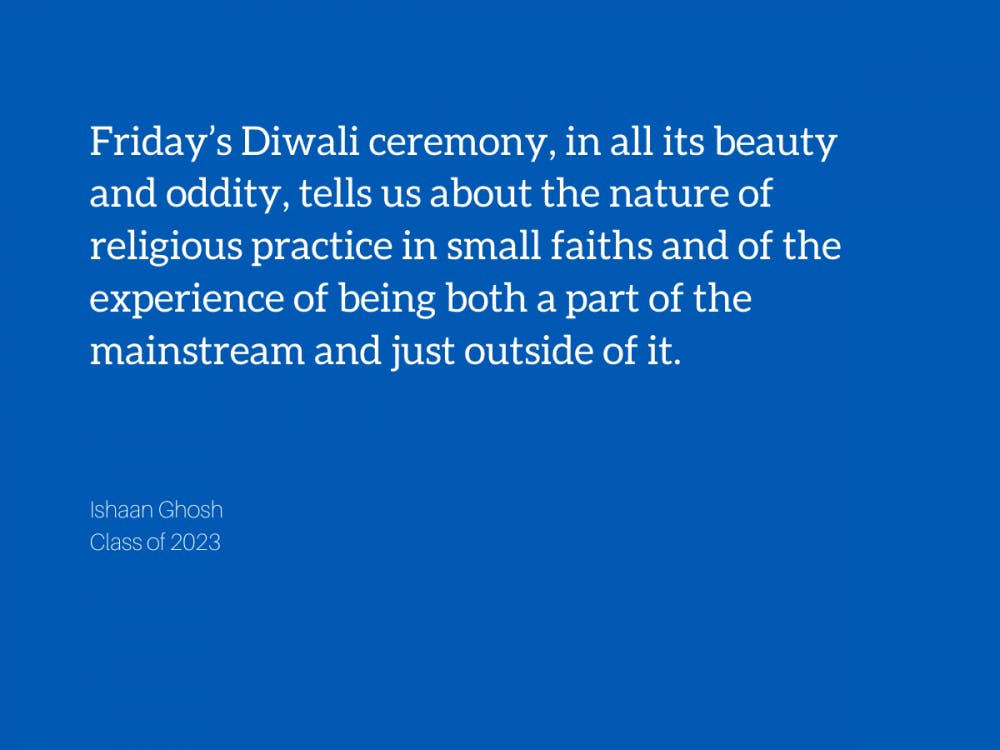I was very nearly late to the Diwali service at the Chapel on Friday evening, victim to a last-minute clothes change and the vagaries of the late-night bus schedule. I met my parents, who were here for family weekend, on the Chapel Steps and walked in just before the main service started.
Perhaps appropriately for a holiday falling so close to Halloween, the lights were dimmed inside the Chapel, giving an eerie, ghostlike feeling to the whole ceremony. In place of the normal lighting, little artificial candles lined the pews and formed an “om” symbol outside the main doors.
The service itself followed a format quite familiar to me, a mixture of religious ceremony and artistic performances celebrating Indian culture and heritage. There were pujas dedicated to Lakshmi and Parvathi and various ancient Sanskrit hymns and songs. In place of a sermon, there was a short speech by a Duke professor at the Fuqua School of Business about knowledge. Following that, the student group Sangeet performed various classical Indian songs. The music was excellent, featuring complex melodies, well-executed vocal maneuvers and distinctive sound of the harmonium, an accordion-like instrument used in Indian music. We all grabbed some laddu as we left.
In many ways, the fact that this service was happening at all was a great victory for the Hindu community at Duke. This was the third time that Duke held Diwali celebrations in the Chapel. The fact that a non-Christian group could hold an event in Duke’s most iconic building is a great step in increasing recognition of the Hindu community, allowing it to fully take its place in the quilt of Duke religious organizations.
This progress is especially important given that Hindu students have no space comparable to the Freeman Center for Jewish Life or the Muslim Life at Duke building. As the Community Editorial Board pointed out earlier this year, the main space dedicated to Hindus here is a small prayer room in the greenhouse level of the Bryan Center. I went there once on a lark. It took me several tries to find the elevator that took me to the greenhouse level, and once I got there, I was greeted by a bare, windowless room. Needless to say, this is not exactly the most prominent location for a religious community, which makes the significance of holding the ceremony in Duke’s most prominent building even greater.
I did, nonetheless, sense something almost cosmically absurd about the whole ceremony. The fact that a religion that places strong emphasis on idol-worship was holding a ceremony in a Christian church was not lost on me. There was a definite contrast between vast the scale of the Chapel lighting and the artificial candles lining the pews which can be bought in sets of 24 for $9.50. Instead of standing on the lectern where the sermon is normally delivered, the priestesses and the speaker stood in front of the first row of chairs, meaning that the audience sitting further back likely had trouble seeing them. It felt almost as if the Chapel was too grand a setting for a ceremony like this.
The Diwali ceremony, in all its beauty and oddity, tells us a lot about the nature of religious practice in small faiths and of the experience of being both a part of the mainstream and just outside of it. Growing up, I remember going to Pujas and cultural events in rented high-school gymnasiums and cafeterias. Here at Duke, the last Hindu puja before the Diwali ceremony at the Chapel took place in a mostly-empty room in McClendon Tower in West Campus. That puja consisted primarily of a couple dozen or so people sitting criss-cross on the floor singing Sanskrit hymns.
For myself, and I suspect for many others as well, Hinduism is something that is done as a guest in someone else’s space.
The lack of a dedicated religious space does not mean that Hindus in the United States are somehow spiritually deficient. Upstart and diasporic faiths all over the world understood that grand temples or mosques are not needed to foster religious feeling and community. When the Christian faith was just getting started, Jesus said to the people of his nascent community, “where two or three of you gather in my name, there I am with them” (Matthew 18:20, New International Version). A religion is not a building, and religions can thrive without permanent spaces of worship.
Nevertheless, I suspect that the lack of a permanent space of worship (apart from that tiny room hidden away in the Bryan Center) might be behind some of the contrasts of the Diwali ceremony. Despite the victory of being able to hold a ceremony in the Chapel, the Hindus were still fundamentally guests of someone else. There were probably good reasons for some of the oddities which I observed. The artificial candles were probably used because they are safer and more affordable than regular candles. Maybe the lectern was not used because they did not want to possibly disturb the altar area for the people who normally used it. But all of these good reasons still emphasized the Hindus’ status as outsiders, who could temporarily use the Chapel for our purposes before giving it back to its real owners.
In the end, the Diwali ceremony was emotionally complex for me, revealing both the beauty of Indian culture and the difficulty of true integration into the mainstream. Maybe, however, that is the point. Being part of a minority is frequently a delicate balancing act of being both a part of the mainstream and not a part. Perhaps the Diwali ceremony is a celebration of this reality.
Ishaan Ghosh is a Trinity first-year. His column, sacred and profane, runs on alternate Tuesdays.
Get The Chronicle straight to your inbox
Signup for our weekly newsletter. Cancel at any time.

